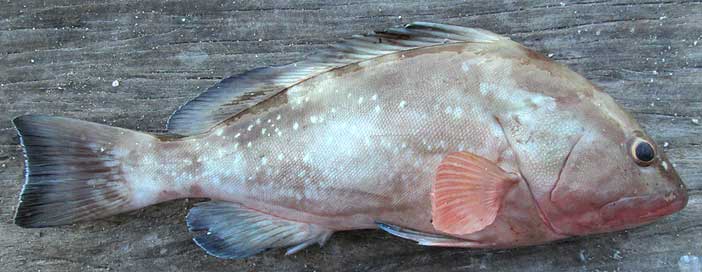Excerpts from Jim Conrad's
Naturalist Newsletter

from the January 25, 2015 Newsletter issued from Río Lagartos, on the Yucatan Peninsula's northern coast (~N21.60°, ~W88.16°), Yucatán state, MÉXICO
RED GROUPER
On flamingo-viewing boat rides the guides sometimes bring along dead fish to toss into the water to attract crocodiles and/or fish-eating raptors to within tourist picture-taking range. One such fish was the eight-inch one (20cm) shown above.
It's worth paying special attention to this fish's long, topmost fin. Atop most fish bodies there's a "spiny dorsal fin" up front and a "soft dorsal fin" farther back. These dorsal fins may be slightly connected, completely separated, or, as in our fish's case, grown together, forming a continuous fin from front to back. On our fish's continuous dorsal fin you can see that the front part, representing the spiny dorsal fin, has thicker, longer spines than the back part, where the soft dorsal fin is held up by soft "rays," not spines. When identifying fish, often it's true that color and markings vary greatly among individual fish within a species, but the general configuration of the fins, and the fins' number of spines and rays are constant within the species, and therefore are very important identification features.
However, this fish with its slightly unusual continuous dorsal fin, pinkish side fins (pectoral fins), general shape, and the fact that it's a commonly caught and well known species, was easy for volunteer Identifier Bea in Canada to identify even without counting spines and rays. It's the Red Grouper, EPINEPHELUS MORIO, distributed in the Western Atlantic from North Carolina in the US (straying north to Massachusetts) to southern Brazil, including the Gulf of Mexico, Caribbean, and Bermuda. It's a member of the Sea Bass Family the Serranidae. In Spanish Red Groupers are called Meros.
And the Red Grouper's spine count is: dorsal spines 11; dorsal soft rays: 16-17; spines of anal fin: 3; anal fin soft rays: 8-10.
A 2001 study by Enrique Giménez and others found that in the body of shallow water immediately north and west of the Yucatan Peninsula known as the Campeche Bank, the Red Grouper's food consisted of fish (28%), crabs (43%), and shrimps (18%).
The Red Grouper is a much-fished species that can grow a lot larger than our eight-inch one -- up to four feet (125cm), with a maximum published weight of 51 pounds (23kg). Being such an important food fish, why had ours been "thrown away" to now serve as crocodile bait? I'm guessing that it was caught by net and was too small for the local fishing cooperative to accept, because of regulations dealing with minimum sizes. Lots of such unwanted fish die when they are discarded after being caught in nets.
In the US, this year the fishing season for Red Grouper is closed from January 1 through April 30, and the length limit is 20 inches, twice the size of ours. Mexico's SAGARPA agency recognizes that Red Groupers are being overfished. A Mexican government website states that between 2003 and 2006 the Red Grouper catch in the Bay of Campeche dropped 70% from levels registered in 1972. The official document in Spanish describing the situation is available online here.
Ecologically, Red Groupers are important not only because as predators they keep other fish populations in balance and cull out the slow and sick but also because they excavate pits on the seafloor, which attract other species, increasing ecosystem diversity, thus strengthening it. In many areas the invasive Lionfish is invading Red Grouper habitat and scientists are anxious to see how this disturbance affects the whole marine ecosystem.
A curiosity about the Red Grouper's life cycle is that the fish begin their lives as females, but then most of them transform to males between the ages of seven and fourteen. When animals are born as females but later change to being male, they are said to be "protogynous hermaphrodites."